New perk! Get after it with local recommendations just for you. Discover nearby events, routes out your door, and hidden gems when you sign up for the Local Running Drop.
How Dean Karnazes became the biggest celebrity in ultrarunning – and where he’s running next
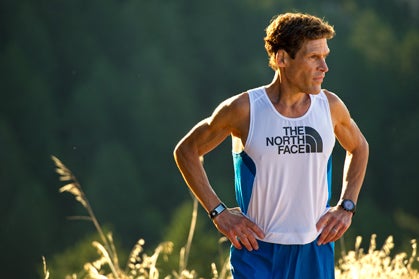
Photo by Corey Rich
Dean Karnazes does not sit still. America’s most famous ultrarunner ran up to meet me in a park near his home in Ross, a quaint and affluent town north of San Francisco, and politely declined to sit at my side on a bench.
“That’s OK, I’m good,” he said with a big grin that cut across his long, square-jawed face. Then he started doing squats and calf stretches.
His smile revealed tiny, barely visible white hooks on a couple of teeth, which are part of his concealed orthodontia, odd for someone his age—he turned 49 last August. His wife, Julie, a dentist, installed them after his 75-day, nearly 3000-mile run from Los Angeles to New York dubbed the “Run Across America,” that he completed last spring.
Long stretches of his 40- to 50-mile daily runs were along a narrow highway shoulder with big rigs repeatedly zooming by and honking. “I was clenching my teeth and literally made them crooked, and my jaw started hurting,” he explained.
Karnazes wore running shorts, a singlet emblazoned with his main sponsor, The North Face, and a backpack to carry stuff, since he literally runs errands around town. The stretching movements on his 5’9″ frame made his veins pop and muscles flex in heightened definition under his tan, taut and seemingly hairless skin.
Our plan was to do an interview while running up some fire trails on the east side of Mount Tamalpais. He said he didn’t mind holding my voice recorder while we ran because he is accustomed to dictating into a recorder during long runs. That’s how he produced the first drafts of his 2005 blockbuster memoir—Ultramarathon Man: Confessions of an All-Night Runner—and his two follow-ups: 2008’s 50/50, about lessons learned while running 50 marathons in 50 states in 50 consecutive days; and his 2011 release, Run! 26.2 Stories of Blister and Bliss, a collection of humorous and reflective short stories that explore his relationship to running and to the people close to him.
It’s hard not to feel intimidated by the prospect of running with Dean Karnazes. The New York Times wrote that running with him is “like setting up one’s easel next to Monet or Picasso.” This is a guy who has over 66,000 Facebook fans, who in 2007 made Time magazine’s list of “Top 100 Most Influential People” and who once stayed awake for three days to run 350 miles nonstop. A guy whose next big project is to run a marathon in all 204 countries around the world in a year.
But Karnazes set a comfortable, conversational pace, and his form looked relaxed and balanced as we ran up a sidewalk in the leafy neighborhood. In fact, his whole persona seemed easygoing and regular—not exactly ordinary, because most runners aren’t so fit and photogenic, but not particularly special, either.
Karnazes’ coach, Jason Koop of Carmichael Training Systems in Colorado Springs, says that Karnazes actually is a very “normal” athlete physiologically: “He doesn’t have superhuman genetic capabilities of taking in a lot of oxygen or anything like that,” and at the lower intensities he runs many of his adventures, “he’s able to go and go and go. … He’s a normal guy in every sense of the word and just happens to be able to do extraordinary things.”
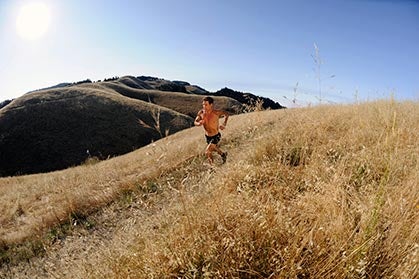
Karnazes on one of his backyard favorites, Mount Tamalpais, San Francisco
Early in our run, the conversation turned to the Western States 100-Mile Endurance Run, and I asked what he thought about the 2011 performances. He expressed awe and respect for the lead runners who finished under 16 hours. (Karnazes didn’t run Western States last year, though he has 11 sub-24-hour finishes there, with a best of 17:43 in 2003 when he placed fourth.) “How about that Kilian?” he said of the race winner, Spaniard Kilian Jornet. “That kid was insane! What a great ambassador. I love everything he stands for.”
We hit the Phoenix Lake trailhead, a regular destination for Karnazes, and he mentioned he often does this run solo on weekdays at 4 a.m. “I fit running in when I can,” he said. Recently, between traveling, writing, parenting, speaking engagements and sponsor commitments, he’s been averaging about 80 miles a week. “When I’m in between events, like now, and just maintaining my base, I like it to be free flow.”
Then he asked if I would mind tacking on a couple of extra miles on a trail that would take us to the neighboring town of San Anselmo, where he opened the “U-Top It” frozen yogurt shop in early 2011. “I just need to go by the shop to stick my head in and let the employees know I love them,” he said.
“Of course,” I said, wanting more time together to hear about what motivates Karnazes to test the limits of endurance in places as unforgiving as the South Pole, where he nearly froze running a marathon in 2002, or as hellishly hot as Death Valley, California, where he finished the 135-mile Badwater Ultramarathon eight times and won it once.
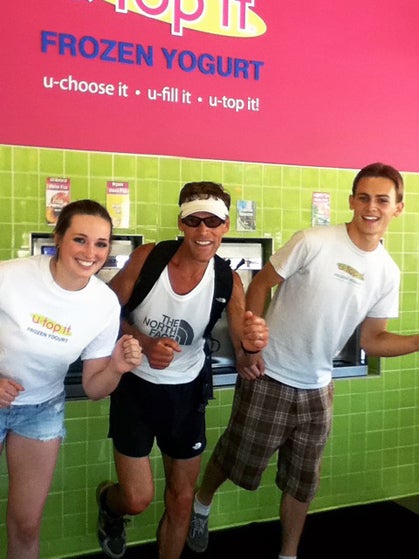
Hamming it up with his employees at U-Top It. Photo by Corey Rich
But I had to wonder, with everything else he has going on, why did he open a fro-yo shop? “Good question,” he said, laughing. “I never looked at it as a money-making thing, really. I wanted to invest in the community and bring some jobs in, but at the end of the day you still have to pay the mortgage.”
Over the course of our run and in subsequent conversations, he would reflect on how his goals have shifted over two decades as an ultrarunner and why he’s on a mission to change people’s lives by getting them to run. He would also open up about the criticism that his celebrity status has sparked. But for the first several miles, we kept the conversation light as he relished the climb up the mountain’s back side—“Isn’t this the best place in the world? It’s insane!”—and bantered about his two kids: Alexandria, 16, and Nicholas, 13.
Alexandria, Nicholas, Julie and his parents have crewed for him on numerous ultras over the years. The whole family would follow Dean in an RV dubbed “The Mother Ship.” When he did the Endurance 50 project in 2006—50 marathons, 50 states, 50 days—the kids traveled around the country while Julie and the grandparents home-schooled them on the road. “They used to love traveling to ultras, and then it was kind of, ‘I don’t know if I want to because my friend’s having a party,’” he said. “I don’t want them to be like, ‘Dad’s dragging us to another thing.’”
We reached a summit and paused, taking in a panoramic view of the San Francisco Bay. “Our house is on that hill over there,” he said, pointing. “When I run up to Tam, I bring this little safety mirror, and signal my kids, and they’re like, ‘Hey, Dad’s up there!’”
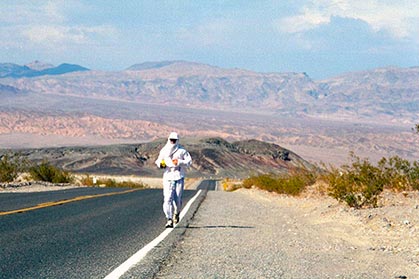
Karnazes running the Badwater Ultramarathon. Photo by Corey Rich
The First 30
Karnazes has traveled an incredibly long way—literally, in terms of miles run on all seven continents, and, metaphorically, in terms of his personal evolution—since a fateful night in 1992, when serendipitous circumstances turned him into an ultrarunner.
“What really got me going was bad tequila. I had a midlife crisis on my 30th birthday in a bar in San Francisco,” Karnazes explained to a crowd at a book signing a few months ago. In his memoir, he details how he got seriously loaded for the first time in years, and was hit on by an attractive woman. He loved Julie, whom he fell for back in high school—“not just some fleeting high-school infatuation, but genuine, head-over-heels love,” he wrote in Ultramarathon Man.
On the verge of being unfaithful and knowing he’d regret it, he made an excuse to use the restroom, escaped through a back door and made it home. He stood on his porch and just felt like running—something he hadn’t done since high school, when he ran track and cross country in his Southern California hometown of San Clemente. He found some tennis shoes, took off his pants and jogged south in his silk underwear.
On that nighttime run, he grieved the loss of his younger sister, Pary, who was killed in a car crash 10 years earlier on the eve of her 18th birthday, when Dean was an undergraduate at Cal Poly. Her death had devastated his close-knit, Greek family and prompted Dean to quit partying, earn an MBA and fast track a career in the marketing department of a health-care company.
He also faced the fact his job didn’t entirely satisfy him. “I had grown accustomed to the upscale lifestyle, the bonuses, the hefty options packages,” he wrote. “But I couldn’t ignore the nagging sense that something was missing. I needed a sense of purpose and clarity—and perhaps adventure.”
That night he ran 30 miles, ending up in the seaside town of Half Moon Bay. How could he run so far on untrained legs? “It’s amazing what you can do when you’re drunk,” he says. “I was intoxicated … and then I wasn’t, and then it started to hurt like hell. But I made it 30 miles and shocked myself.”
By the following year he had become an ultrarunning fanatic and entered his first 50-miler. When he heard about Western States, he told himself, “‘You gotta try to get yourself to that level.’ It wasn’t a desire to do well competitively. It was just, ‘Can you make it?’” He trained and, in 1994, finished Western States in 21:01.
The next year, he attempted Badwater and passed out at mile 72. “It was a complete devastation not to finish,” he says. He went back to complete it in 1996 and entered a period of participating in extreme sports, including mountain-bike and adventure races. He also kept windsurfing, a sport at which he competed at a pro level during and after college.
In that first decade as a serious athlete, though, he was like everyone else at the starting line, an unknown shoehorning his training in between managing a career and starting a family.
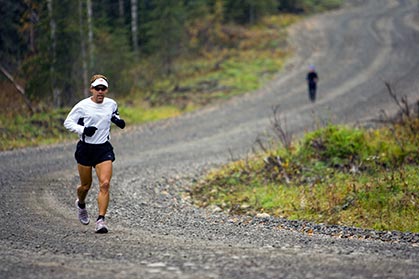
Karnazes during the Endurance 50. Photo by Corey Rich
The Relay and Running for a Cause
I first heard of Dean Karnazes in October of 2000 while riding in a van packed with sweaty runners on a back road of Northern California’s wine country. Our van represented one of dozens of 12-person teams competing in The Relay, a 199-mile event to raise money for the cause of organ donation and transplants.
One of my teammates piped up, “There’s a guy doing the whole thing himself. He’s called Team Dean. Rumor has it he eats whole cheesecakes along the way.” 199 miles? It seemed unfathomable to me. But it was true. Dean Karnazes ran The Relay from Calistoga to Santa Cruz solo 10 times, starting in 1995 and most recently in 2009, refueling with unconventional food and drink purchased along the route: entire pumpkin pies, pizzas rolled up and held in his fist like a giant burrito and liters of Pedialyte.
He started running The Relay as redemption for DNF’ing at Badwater. Very few events longer than 100 miles existed back in the mid-1990s, he says, and, “I heard about this 200-mile relay race and thought, ‘Well, there’s a distance that’s farther.’ … ‘You gotta bounce back—you failed at 135.’”
In 2000, he dedicated his 199-mile effort to raising money and support for the family of a dying girl in need of a liver transplant. The story had a happy ending: She got the transplant and survived. Then the story repeated in the following several years: Dean dedicated the annual run to a hospitalized child, and that child miraculously got the transplant or treatment needed to recover. In 2003, he founded Karno Kids, a nonprofit foundation to support programs for youth health and fitness.
As he wrote in Ultramarathon Man, “That string of miraculous outcomes left me with an eerie sense of providence, as if it were somehow my calling to be involved. I’m not getting saccharine here, and believe me, I’d probably be running like a wildman no matter what, but thinking about my sister, and being able to help others, has given me a greater sense of purpose.”
Not content to keep running “just” the 199-mile relay solo, he started adding miles to the course, either before or after the finish line: a total of 262 miles in 2004, and then 350 miles in 2005, which raised thousands of dollars for a two-year-old girl in need of a heart transplant.
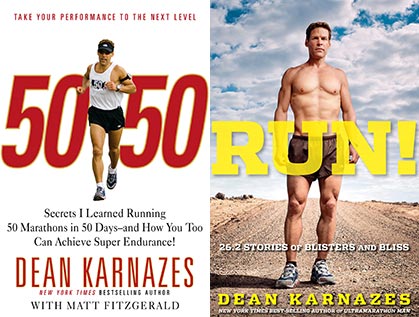
The Rise of “Ultramarathon Man”
Writing a book was on his “life list,” says Karnazes, something he wanted to do but didn’t expect to be of much consequence. As it turned out, the publication of Ultramarathon Man in 2005 fundamentally altered his life.
The book shot up the bestseller list—it was the No. 7 sports book worldwide that year—and made Karnazes a star. Suddenly, he was everywhere—on numerous magazine covers and TV shows such as Late Night with David Letterman and Today. Readers ate up the book’s comic details, such as his account of cramping to near rigor mortis after a race and projectile vomiting all over the steering wheel of his Lexus. And they gained motivation from his retelling of the times he almost gave up but didn’t, such as when he staggered around Mile 80 during his first Western States due to night blindness and passed out on the trail.
But it’s more than athleticism and good storytelling that propelled Karnazes’ popularity and gave rise to the de facto “Ultramarathon Man” brand, which promotes everything from mattresses to elliptical bicycles. For that, credit is due to his well-honed business and marketing skills, relationships with sponsors and ability to connect with fans.
Before the book was published, Karnazes developed a close partnership with his primary sponsor, The North Face. He started out as a shoe tester in the late 1990s and signed a contract in 2002 as a sponsored athlete. During that period, he developed a company, Good Health Natural Products, where he was president until he left in 2008 to become a full-time runner, writer and motivational speaker.
As he was garnering media acclaim for his book, Karnazes and The North Face were busy planning Karnazes’ first mega-staged event, one that would have a far-reaching legacy: “The Endurance 50,” aka 50 marathons in 50 states in 50 days, which would kick off in September 2006.
A couple of months before Karnazes started the Endurance 50, he ran another Western States 100, won the Vermont 100 in 16:26 and completed another Badwater—all in a one-month period.
Karnazes told me the project had a “very organic” genesis: “My family and I had grown closer through running, so I thought, wow, let’s adventure across this country and do something extraordinary.”
Recognizing the logistical challenges—staging marathons on weekdays on certified-distance courses, gaining permits and closing roads, getting the crew from one state to another in 24 hours, providing aid for Karnazes and the runners who ran with him—The North Face hired Hawkeye, a marketing and strategic-planning firm based in Dallas.
The Endurance 50 was a success, and Karnazes capped it off by running 3:00:30 at the New York City Marathon on his final day. Filmmaker JB Benna captured the journey in his film UltraMarathon Man, and Competitor magazine named Karnazes “Runner of the Year.” The project gave rise to the popular North Face Endurance Challenge Series the following year, which by 2011 had grown to two-day events in six cities, featuring distances from 5K to 50M mostly on trails and a $10,000 prize at its year-end championship, the most in U.S. trail running.
What barely made it in the mainstream press, though, was the fact that another ultrarunner—Sam Thompson, then 26, originally from Mississippi, now living in Seattle—was nearly finished with his own 50-50-50 run when Karnazes started The Endurance 50. Actually, Thompson ran 51 marathons in 50 days in all states, squeezing in an extra marathon in Washington D.C. He had embarked on the project to raise awareness for the Gulf Coast communities devastated by Hurricane Katrina.
I asked Thompson if he got the idea from Karnazes and if he timed his project to be the first. He said, no, that the concept occurred to him while he was running the Appalachian Trail, crossing states from Maine to Georgia, a couple of years prior. “I wasn’t aware of [Karnazes’] plan until I was a week or so into mine,” said Thompson. “I’m not one to say disparaging things. He did it his way, and I did it mine. I feel mine was a very pure way of doing it. … There’s a lot of confusion over who did it first, but at the end of the day, I don’t care.”
Says Karnazes, “I never said I was the first to do it, because I’m not. … There were never any hard feelings on my behalf and never any strategic positioning to try to outsmart his position.”
Nonetheless, Thompson gained support and sympathy from ultrarunners who admired his low-key, low-budget approach in contrast to the hoopla surrounding Karnazes, and who were annoyed at the general misperception that Karnazes was the first and only runner to do 50-50-50. The impression that Karnazes didn’t do enough to credit Thompson for being the first kindled a backlash and tarnished his reputation among many observers.
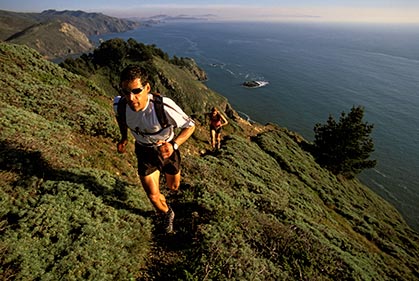
Karnazes running oceanside in Marin County, California. Photo by Corey Rich
“Dean, Dean the Media Machine”
According to longtime ultrarunner Rich Limacher, 61, of Matteson, Illinois, “I and others call him ‘Dean, Dean the Media Machine.’ … It’s when his marketing machine tries to trump everything truly great that the true champions have done, that’s when we who are serious about the sport’s integrity get our feathers all ruffled.”Dissing Dean came to head in 2007 when ultrarunning great Scott Jurek of Boulder, Colorado, expressed frustration in an interview about Karnazes, after seeing Outside’s cover proclaiming him “America’s Greatest Runner.” Jurek suggested Karnazes did not deserve that title, and that the media should focus on the “true champions” of the sport.
Scott Dunlap of Woodside, California, who writes the popular www.runtrails.blogspot.com, posted a transcript of Jurek’s interview about Karnazes on his blog, which sparked scores of comments from trail runners, who were split between defending Karnazes and sympathizing with Jurek. (Four years later, Dunlap says, it’s still one of the hottest topics on his blog.)
Responds Karnazes today, “You can’t read some of that trash talking and not be like, ‘That really stings.’ … I think a lot of it’s misdirected by people who don’t really know what I’m doing and think I consciously set out to be a big media machine. I’ve emerged as the go-to guy if you want to talk about running or ultrarunning, but I try to shine the light back on the sport and the people in the sport.”
Comments Rickey Gates of Woody Creek, Colorado, who set a course record at the 2011 Canadian Death Race 125K, “Whenever I tell someone I’m a runner and do mountain races, they say, ‘Oh, my God, have you heard of this guy Dean Karnazes? He’s amazing.’ People assume he’s the best—and my petty ego has to deal with that.”
Nonetheless, Gates credits Karnazes for attracting more people and attention to the sport, which helps generate sponsorship so athletes like him can take time off from regular jobs to focus on training. “He’s not the best of the best when he toes the starting line, but regardless of how fast he is or isn’t, he’s inspired more people to run than almost anyone out there.”
Take Geoff Harper, a 33-year-old mechanical engineer who attended a book signing for Karnazes’ recent release. Harper walked up to Karnazes and said, “You’ve changed my life.” He said that reading Ultramarathon Man inspired him not only to run more frequently and train for a marathon, but also to get his contractor’s license and start a new business. “I’ve taken actions to move myself forward with what I want out of life” since reading the book, he said, calling Karnazes “probably the single most important person I could ever meet. He’s like a superstar to me—a superhero.”
Karnazes expressed mixed feelings about that label, “Ultramarathon Man.” He said the phrase came from an old article that called him that, and his publisher persuaded him to use it for the book’s title.
“I wasn’t that crazy about it, because it almost sounds like too big of shoes to fill. It’s a brand I try to live down. The super elites go, ‘Aw, he doesn’t deserve that title; he’s never been on the top,’ while the casual, everyday runners go, ‘Oh, my god, this guy is superhuman, I’ll never approach that’—and that’s what I don’t want,” he said during our run. “It’s become the brand, but it wasn’t intentional, it wasn’t scripted—it’s just how it evolved.”
Says Geoff Roes of Boulder, Colorado, 2009 and 2010 Ultrarunner of the Year and the 2011 Ultra Race of Champions winner, “Dean has done some amazingly successful things in the sport. Generally negative opinions come from people who view success in running as being able to run certain races really fast. I don’t define success in running that way, so I have no problem with Dean having had so much success outside the realm of race performance.”
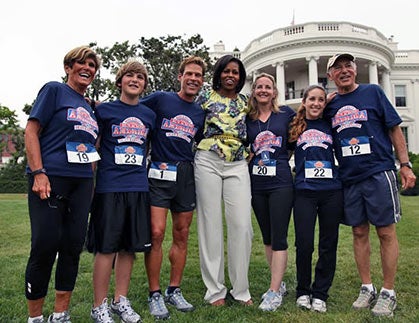
Karnazes with First Lady Michelle Obama during Run Across America. Photo by Corey Rich
On the Dreadmill
Following the 50-50-50 project, Karnazes went on to win 2008’s 4 Deserts race series totaling 1000 kilometers—the Atacama Crossing (Chile), the Gobi March (China), the Sahara (Egypt) and The Last Desert (Antarctica)—each self-supported over seven days and 250K.
That same year, he ran 48 hours on a treadmill in the ABC-TV studio in New York, attempting the world record of 251 miles (he ran 211). The event was hell, he says, but provided an interesting moment when Senator Barack Obama, the presidential candidate, stopped by to say hello at the 42-hour mark. Moments before, says Karnazes, “I got off the treadmill because I was getting chafed, put a big goo of Vaseline in my hand, held my shorts down and did my thing.” All of a sudden, Secret Service guys ushered in Obama.
“Obama said, ‘I think what you’re doing is incredible, and I just want to shake your hand.’ I started reaching for his hand and went, ‘Oh!’ and gave him the presidential knuckle bump.”
The ABC event actually was his third major treadmill run that generated press attention and was derided as “gimmicky” by some ultrarunners.
Karnazes’ “treadathalons” began in 2004, when his friend Christopher Bergland of New York City, winner of three Triple Ironman competitions, asked if he would run at his side to help him break the 24-hour treadmill record. Bergland broke the record at 153 miles while Karnazes ran about 149. Karnazes said it was miserable and told his family, “I’m never doing anything like that again.”
But in 2007, the company Accelerade approached him about doing a treadmill run in Times Square. The treadmill would be suspended on the side of a building, and the event would be broadcast live.
Karnazes accepted, he says, “Because it was my job—it was how I fed my family. Yeah, I got a lot of shit for it, but a lot of people found it hugely inspirational.”
He fell short of breaking Berglund’s 24-hour record, running 130 miles. “It was the most brutal thing. Every time one of those plasma screens lit up, it was like a dose of radiation,” he said, laughing, “but it made me appreciate trail running a lot more.”
Running Across America
Before Karnazes’ Run Across America began last February, the Hawkeye team meticulously planned the route from Los Angeles to New York and coordinated with WABC-TV in New York to cover the event on morning TV for 75 days.
“At first I thought, why would I want to do this? I had never watched Live! With Regis and Kelly, and I can’t imagine anyone in my peer group watching morning TV,” Karnazes recalled. “Then I thought, the demographic watching this is probably the folks that need the most inspiration to get off the couch. If I’m going to do something that makes me feel best, which is helping others be the best they can be, then I have to use the media.”
Brandon Friese of Denver, an independent contractor for Hawkeye and member of Karnazes’ support crew, said the team used two tour buses, one to transport Dean’s crew and another for the television crew. On most mornings, Friese received a call from Dean between 4 and 7 a.m.—“a lot of times he couldn’t sleep, so he’d want to get started”—and thus began a day of running 40 to 50 miles, which lasted between seven and 12 hours.
Karnazes was “very detail oriented,” says Friese, wanting to know the elevation profile and terrain before each day, and he was “pretty regimented with his food.” The crew would mix yogurt or Ensure with granola and nut clusters, hand him the bowl, and he would eat while walking. “His big thing was always forward, always moving.”
Karnazes and his entourage reached D.C. in early May. Television from that day shows Karnazes running through the streets with a pack of schoolchildren following his lead and the television host Kelly Rippa jogging at his side. They ran through the gates to 1600 Pennsylvania Avenue to the White House lawn, where Michelle Obama high fived the school kids, greeted Karnazes’ family—who had flown out for a White House tour—and hugged Karnazes.
Michelle Obama told the schoolchildren and the national television audience, “I want kids everywhere to look at Dean as an example. … Exercise! Eat healthy! Keep moving!”
After three hours in the White House, Dean recalled, “I finally told them, ‘I’ve still got 30 miles I’ve gotta run today,’” so he left and kept going toward New York. “I can’t even believe it’s me who lived that experience [at the White House]. “I was like, ‘I’m a runner, what am I doing here?’ It was surreal.”
Going Global
How will Karnazes one-up himself next? Go global. Tentatively called RunWorld, Karnazes’ next big thing is to run a marathon in every country over the course of a year, starting in late 2013 or 2014. He envisions people in each country running all or part of a marathon with him, and raising money for a charitable cause in each nation.
“It’s gonna be a beast,” he said. “Having a goal like that, which involves logistics, planning, geography, culture—that’s something that completely engages me.”
“It takes millions of dollars to pull something like this off,” he added. He’s hoping to secure $4 million to $5 million in funding and says he is close to signing deals with major sponsors and a media partner.
We reached Karnazes’ frozen-yogurt shop at the end of our run, where one worker offered him some new chocolate toppings to try, but he passed. “I used to eat junk food, tons of junk food, but I don’t anymore,” he said.
Karnazes, who had barely broken a sweat, said he was happy to squeeze in a midday run, because he was preparing for the Gore-Tex TransRockies Run, a five-day staged race, and he needed some heat training.
At the TransRockies Run, he and the race organizers launched “Run a Day with Dean” that gave journalists and contest winners the opportunity to run at Dean’s side. At The North Face Endurance Challenge Series events, he also acts as host and ambassador—not competitor—by introducing each race and running part of the way with runners. His role at these events typifies his less competitive approach to running now. But he misses racing and says he may toe the line at some events in the coming year.
“It’s been a tough thing for me to watch my level of athleticism slip,” he says. “My God, I’d love nothing more than to go run hundreds of miles by myself, or to run Western States or Badwater, but to me, the biggest reward is having someone come up and say, ‘You changed my life. I’m now a runner because of you.’”
Sarah Lavender Smith is a Bay Area writer who blogs about trail running and travel at TheRunnersTrip.com. This article originally appeared in our January 2012 issue.
